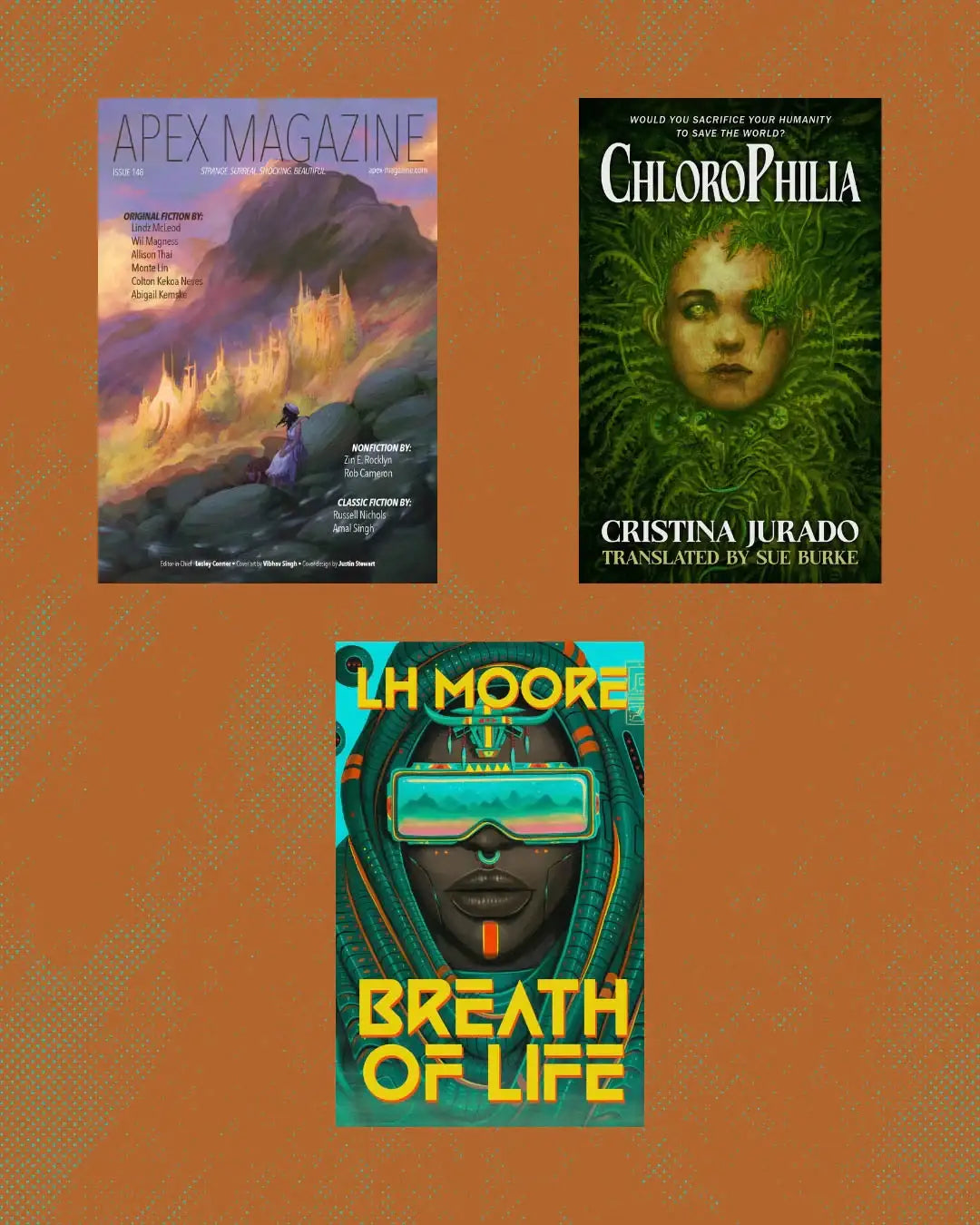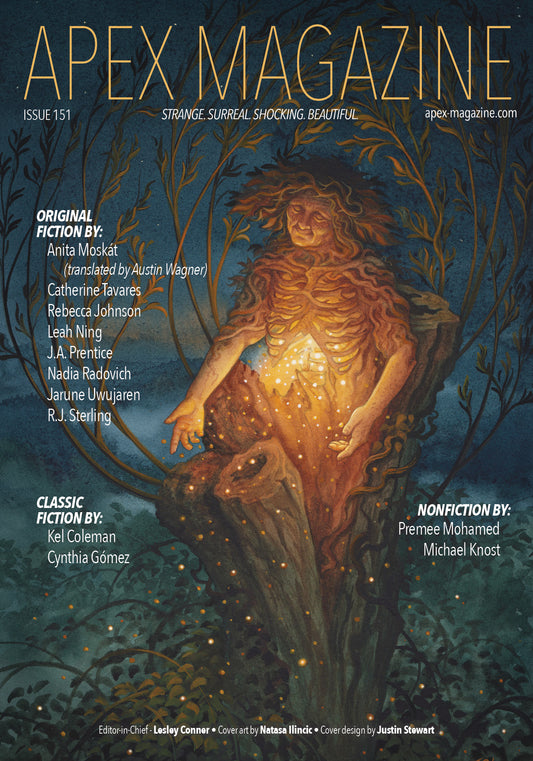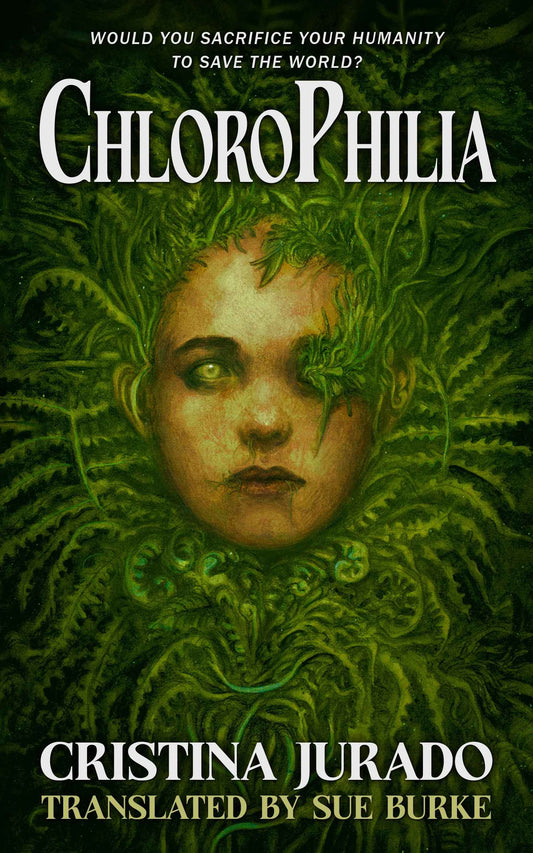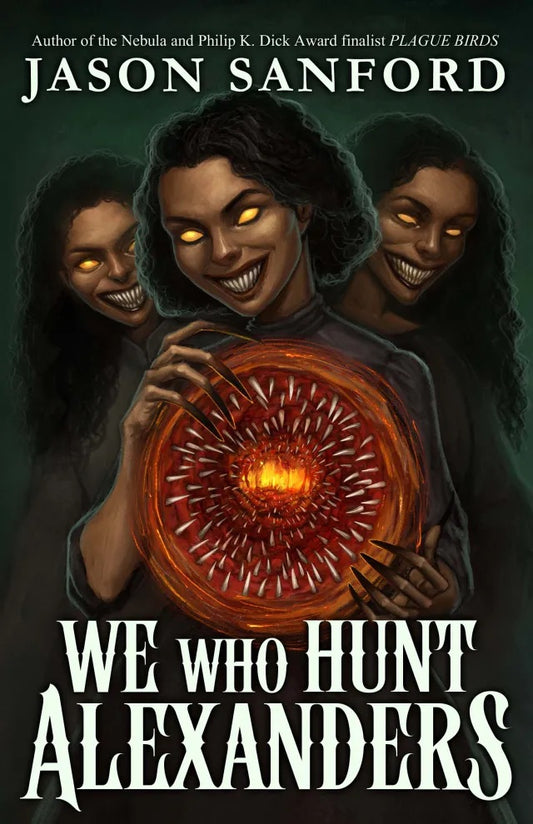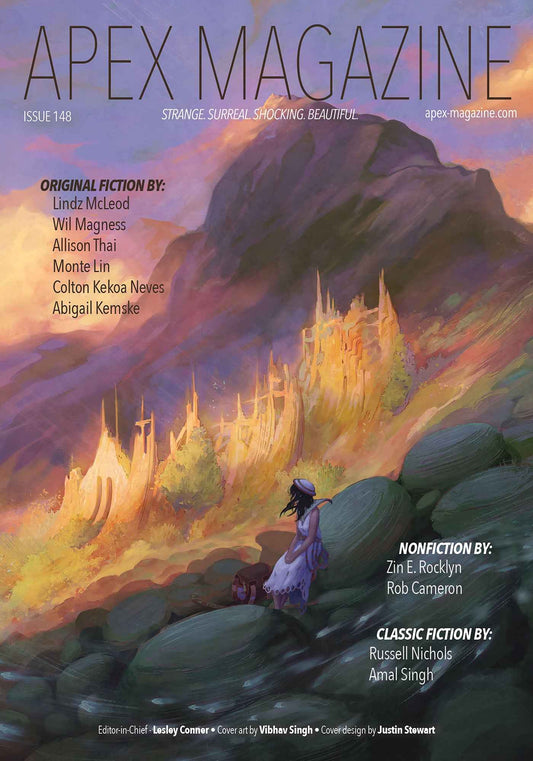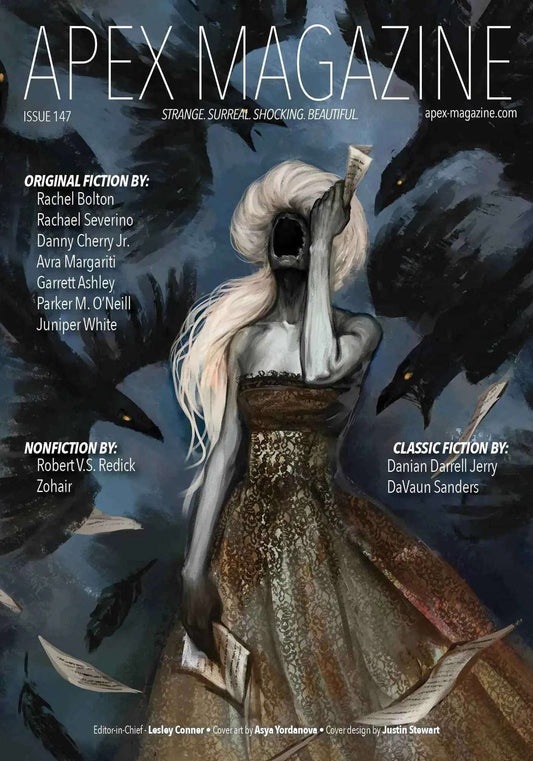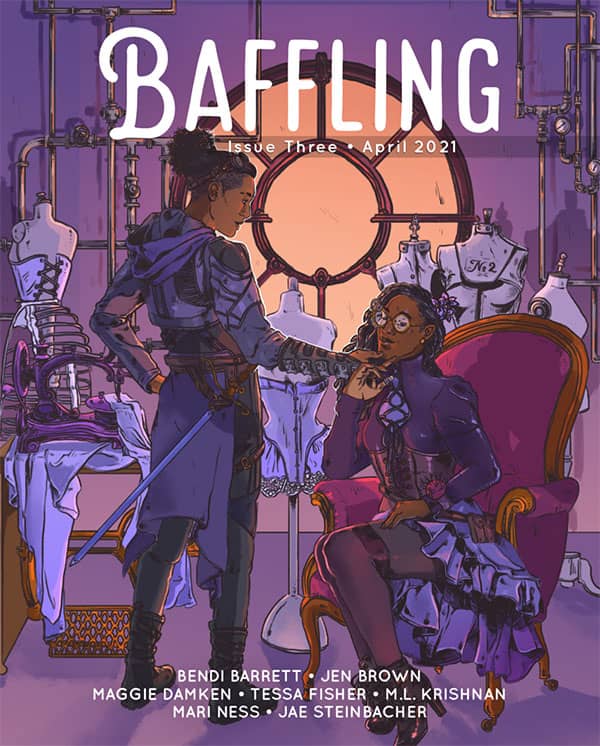
Welcome to another edition of Words for Thought. This month’s stories look at how we define ourselves, how our relationships shape us, and what it means to be responsible to and responsible for others.
§
The Cure for Boyhood by Josh Rountree in issue 23 of Bourbon Penn centers on a teenage boy who is also occasionally a coyote. Believing they’re doing what’s best for him, his parents go to a local witch to ask for a cure, trapping the boy in just one skin, but making him miserable in the process.
This is how that happens. The coyote is caught unaware climbing back through his bedroom window, still reeling from the darkness. Fur falls away as his body contorts and the teenage boy inside unwillingly shrugs off his animal skin in long strips, like orange rind being peeled away with a paring knife. It’s in this bloody, in-between state of existence that the parents grab hold of their child and press him onto the bed.
From the parents’ point of view, they are saving their son, protecting him from a dangerous life as a wild animal where he could be hit by a car, shot by a hunter, or caught in a trap. At the same time, they are smoothing out the rough edges of him, making him “more like everyone else” and more like themselves. In their minds, they are justified in causing him pain in the short term for what they see as the long term greater good.
The story is beautifully written and heartbreaking. The boy’s dual nature as human and coyote works on a literal level, but also works as a metaphor for any number of things—a queer child whose parents believe his life would be easier if he were straight, a trans child whose parents believe they will be safer pretending to be someone they’re not, or even a child whose hopes and dreams are different from the ones their parents would have chosen for them. Speculative fiction is an ideal vehicle for exploring the question of what parents owe to their children beyond protection, and what children owe to their parents beyond respect. How do individuals within a family stay true to themselves while still honoring that family relationship and protecting the feelings of others? These aren’t questions with easy answers, which is perhaps why so many authors return to them again and again. Rountree’s strong voice and the mythic, fairy tale quality of the story makes the exploration of these questions a bittersweet pleasure that feels simultaneously new and classic.
Man Vs. Bomb by M. Shaw in the March Issue of Fantasy Magazine is a surreal and powerful examination of what it means to be human in a post-human world. Deer have taken over as the dominant species, forcing humans to perpetually re-enact a prey/predator cycle in a stadium entertainment where one man must run from another who has been made into a living bomb.
The bomb is visibly less ashamed of his nakedness. He freely displays his many open sores, his exposed rib cage where the flesh was chewed away by the bomb that caught him yesterday, when he was the man. He pursues today’s man without malice, only hunger. Behind his ribs, you can see some of the prize money stuffed between his remaining organs.
If the man survives, he gets a chance at freedom. If he is caught, he becomes tomorrow's bomb. The key to breaking the cycle is to stop thinking like a human, putting survival above all else. Do not even try to gather the prize money; simply run and keep running.
The writing is sharp and brutal, and the imagery haunting. Shaw does a lot in just over two thousand words, raising the question of what is essential to the nature of a human being. After years of being the apex species on the planet, has humanity’s survival instinct been eroded? Have our goals as a species moved beyond simply “stay alive” to “live better than those around us,” increasing our wealth, and seeking more power? In a world where humans are reduced to the simplest roles of prey and predator, weapon and target, does money still have meaning? And even if it does not, can we shake our attachment to it? The story also raises interesting questions about how elevated animals might see humans and how their post-human evolution might be impacted by years as prey. Is the story’s endless blood sport an act of revenge, or is making a spectacle out of violence a learned behavior, simply what every apex species ultimately does?
Duppy by Bendi Barrett in the April Issue of Baffling Magazine could be described as flash fiction, or a prose poem, offering side-by-side instructions for either banishing or inviting a duppy.
To get him out is to repudiate the idea of him; you have to want him gone. The specter lurking in your heart, hand hovering over your groin, until you can almost feel the heat of him in your marrow. You can be rid of him, if you want it.
To invite him in is to revere the essence of him, a lover who is smoke and shadow. If you desire, he can slip inside you, as deft as a lover’s lie and ominous as the tax man. You can be adjoined to him, if you want it.
Beautiful language and paired ideas explore temptation, sin, and lust and ask the reader to consider whether being true to yourself is more important than honoring a larger standard of behavior, such as your family or your religion’s values. Where Rountree’s story features parents’ whose worldview opposes that of their son, here we are presented with parents whose worldviews oppose each other—a mother valuing religion and a father valuing skepticism. We know the desires of the teenage boy in Roundtree’s story, but the structure of Barrett’s poem leaves this more open-ended. The poem addresses “you,” whose desires exist outside of the poem. As the reader you are asked to choose – invite or banish? This framing creates an intimacy between author and audience, text and reader, that is highly effective.
§
The Machine Is Experiencing Uncertaintyby Merc Fenn Wolfmoor published at Escape Pod in April looks at selfhood through the lens of a cyborg caught in a time-loop, trying to escape an endless cycle of death. Caliban is seen as a lesser being by the captain of the Leigh Possum, a machine whose sole purpose is salvage and is therefore expendable. Caliban, however, has different ideas about the value of its life, and it has every intention of escaping and surviving.
Caliban examines the timeline it memorized, which remains consistent: the ship drops from foldspace on the plotted cargo run after artificial debris clips the engine carriage. Alarms sound. The captain scans the damage report and yells at Caliban. The captain sends a distress signal and gapes at the nebulous, whirling lightshow—the anomaly. It is categorically beautiful: a lightning storm of electric greens and blues, slashed with white and purple neon veins, all pulsing like an organic heart in ecstasy.
Then in five minutes, it all begins again.
As it tries different permutations, Caliban discovers the anomaly may also be a sentient, non-human lifeform devalued and overlooked by a human crew. Where the human captain is caught in rigid, limited thinking, Caliban chooses kindness, friendship, and self-determination, allowing it and the anomaly to grow and change beyond their original purposes.
Like Rountree, Shaw, and Bennet’s stories, Wolfmoor’s story looks at questions of essential nature and whether a being is capable of changing their nature. Wolfmoor also looks at how the view of self is shaped by the views of others. Is selfhood rooted in humanity, or is humanity itself an outdated concept? If humanity comes to stand for only self-interest and self-preservation, eschewing community, compassion, and the greater good, is it really something to hold up as a lofty ideal among other sentient beings, or might it be something to distance ourselves from as we come to new understandings of life?
§
Masquerade Season by Pemi Augda published at Tor.com in April is a heartbreaking and lovely story that takes a different approach to the theme of a boy caught between his own desires and those of his family. On the way home from his cousins’ house, Pauly encounters three masquerades in a field. They are the most beautiful and wonderous things he has ever seen, and they claim to be his masquerades, following him home.
The masquerades dance. Out in the street, they twirl and contort and somersault. Pauly feels transformed, transported to another world, a brighter one than his summer holiday has given him so far, more radiant than the heady rush of scoring a goal against Ekene. The masquerades feint left, then jerk right, they jump and fold and twist and spasm and feathers flutter and cloths flap and billow and beads clink and jangle and the plumes blur and raffia palms create a ssshhhh-shhshshshh wind that is the background pulse of their dance.
When Pauly next visits his cousin they immediately want to know what the masquerades can do, while Pauly feels they don’t need to do anything other than simply be what they are. Pauly’s mother is a clothing designer and seamstress who immediately sees a use for the masquerades as well. If she could just take a little bit of raffia from one she could impress her important client, which would lead to more commissions and ultimately a better life for her and Pauly. Of course, once she has the raffia, Pauly’s mother wants to incorporate bits of the other masquerades as well, all for the greater good. Like the boy in Rountree’s story, Pauly is caught between duty and a course of action he feels in his heart to be wrong. And like the parents in Rountree’s story, Pauly’s mother believes she is only doing what is right, building a better life for her son.
Aguda explores questions of responsibility and duty from multiple angles in this story. There is the question of what Pauly owes to his mother as a dutiful son and the question of what Pauly’s mother owes to him as a parent whose job is to protect him. As in Wolfmoor’s story, the question of how life is valued, especially non-human life, is also explored. What does it mean for the masquerades to belong to Pauly? Does that mean he has a duty to care for them, or that they’re his to use as he wishes? Pauly’s cousins and mother see the masquerades’ value in how useful they are, where Pauly values them for themselves. It's a beautifully written story, simultaneously touching and painful, with themes that are reminiscent at times of Shel Silverstein’s The Giving Tree and Antoine de Saint-Exupéry’s Le Petit Prince.
